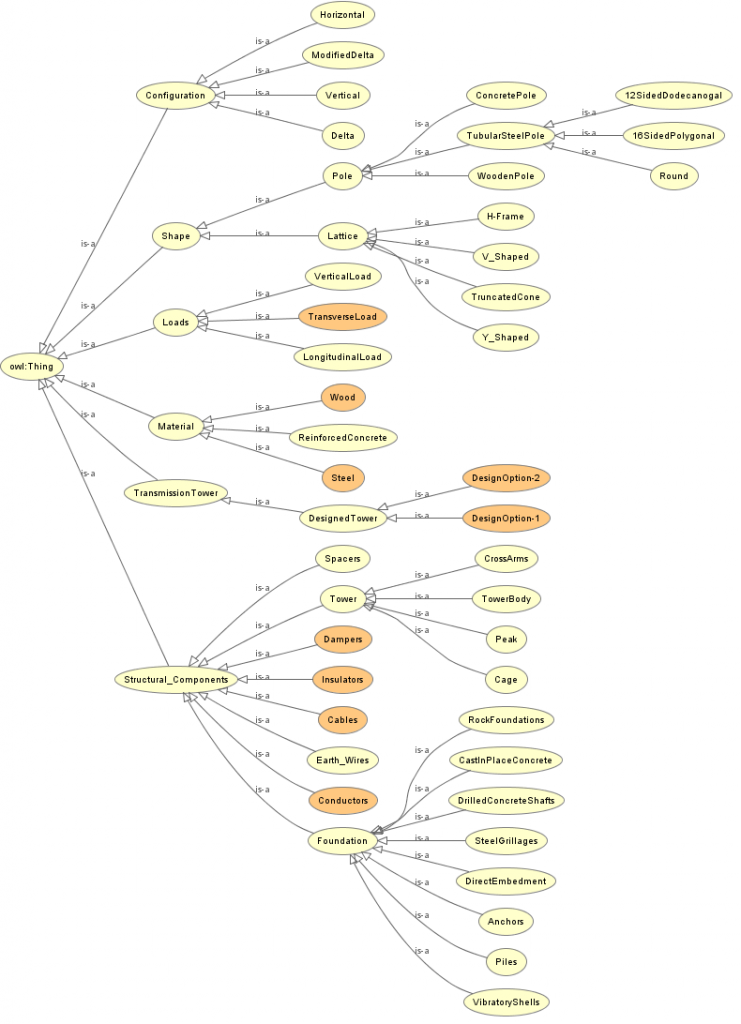Introduction
Transmission towers are some of the most crucial elements of infrastructure in modern times. Naturally, a lot of studies on transmission towers have been done. As the human population continues to grow, and the need for electricity keeps increasing, more and more transmission towers will be required. This is especially true in developing countries where more people are gaining access to a stable supply of electricity every day. Also, the service life of most transmission towers is 70 years[1]. So, every year a lot of transmission towers need to be either replaced or refurbished based on the current demands. I decided to create an ontology for Transmission Towers because they are a big part of our lives and an integral part of global infrastructure.
Ontology of a Transmission Tower
What is the purpose?
This ontology is developed to represent concepts needed for the conceptual design of transmission towers, mainly focusing on the design considerations and structural aspects.
What is the scope?
This ontology includes concepts such as transmission towers’ configuration, loads, materials, shape and structural components.
Who are the intended users?
The intended users are structural engineers and designers involved in the design of transmission towers.
What is the intended use?
This ontology can be used as a knowledge base for the basic conceptual and structural design of a transmission tower. It is a very primitive ontology due to time and resource constraints. It can however be thought of as a starting point for creating more extensive ontology.
Development of an Ontology
Resources [2, 3] have been referred to extensively in order to decide the classes and sub-classes used in the created ontology. A basic taxonomy of a few concepts that are important from the structural design point of view for transmission towers was created. Instances based on existing transmission towers have also been created. It should be noted that every country has their own standards and designs created and adapted based on the local conditions. Hence, a one-size-fits-all type ontology cannot be created.
An overview of all the classes and sub-classes considered is given in figure below.
Fig.1: Overview of all the classes and sub-classes in the developed ontology [taken from Protégé]

Parametric Model of a Transmission Tower
A parametric model for a transmission tower was created. The parametric model created would help a structural designer come up with multiple designs by varying a range of parameters.
Model
The model outputs a lattice framed transmission tower. The base/lower section of the transmission tower has a double web a.k.a. Pratt system of truss geometry. The body/central section has a Portal system of truss geometry. The central section also has side arms that hold the conductors and wires. However, the conductors and wires are not included in the model as they aren’t controlled by the structural designer. The top section is a four sided cone.
High Performance Criteria
Mass
The mass of a transmission tower is an important factor in it’s design. The mass not only affects the cost of the project but also its structural response. Weight optimization of transmission towers is also an active field of research [4].
Center of mass
The Center of mass of the structure is by far one of the most important values for all structural analysis. Knowing its location helps make important engineering decisions.
Engineering Rationale
The Indian Standard – USE OF STRUCTURAL STEEL IN OVERHEAD TRANSMISSION LINE TOWERS – CODE OF PRACTICE (IS 802: 1995) has been referred to extensively in order to come up with the parameters.
The configuration of a transmission tower depends on 3 main factors:
- Height of tower
- Base width
- Top hamper width
The following are considered as critical parameters in the design of a transmission tower:
- Length of cross arm and conductor spacing
- Minimum mid span clearance
- Tower width at base and at top hamper
The parameters base height, body element height, number of levels body and head height take care of the height of the tower. The parameters base width and hamper/base width influence the base width and top hamper width. The length of cross arm is decided by the parameter sidearm width while the conductor spacing and minimum mid span clearance can be satisfied by the parameter body element height. The parameters angle section thickness and angle section width are used to calculate the area of the section and then it is multiplied with the length of each section of the tower to get the volume. This value is then multiplied with the density of steel to compute the high performance criteria – Mass. In order to compute the other high performance criteria – Center of mass, the system is decomposed into 3 parts – base, body and head. The mass of each section is multiplied with the respective centroid positions. This value is then divided by the total mass to find the center of mass.
Sources
[1] Alexandra Kjeld et al. “Life Cycle Assessment for Transmission Towers”. In: (2018)
[2] S. Fang S.J.; Roy and J. Kramer. Chapter 15: Transmission Structure, Structural Engineering Handbook. Boca Raton: CRC Press LLC, 1999.
[3] K.C.Picel J.C. Molburg J.A. Kavicky. “The design, construction and operation of long-distance high-voltage electricity transmission technologies”. In: (2007)
[4] Wadhah A. Hatem and Kadhim R. Erzaij. “Estimation and Analysis of Costs for Electrical Power Transmission Lines in Iraqi Projects”. In: IOP Conference Series: Materials Science and Engineering (2020). doi: 10 . 1088/1757-899x/881/1/012044.
See also other individual systems:
Or main topics:
